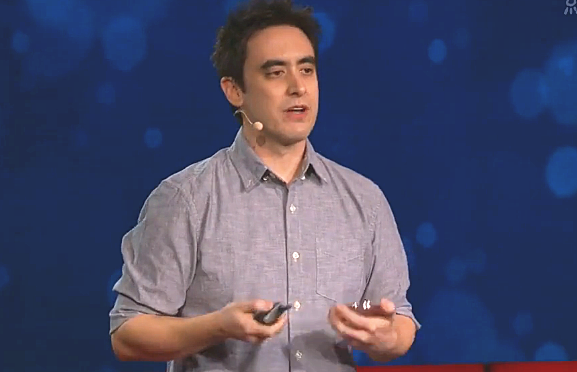So one day I was hacking something, I was taking it apart, and I had this sudden idea:
有一天我正在拆解東西,我突然產生了這樣的想法:
Could I treat biology like hardware?
我能不能把生物體當作硬件?
Could I dismantle a biological system, mix and match the parts
我能不能拆分一個生物系統,混合并配對拆分出來的部分,
and then put it back together in some new and creative way?
然后用全新的創造性的方式把它重新拼裝?
My lab started working on this, and I want to show you the result.
于是我的實驗室開始了相關的研究,我想給你們展示一下成果。
Can any of you guys tell me what fruit this is? Apple!
你們有誰能夠告訴我這是什么水果嗎?蘋果!
That's right -- it's an apple.
沒錯——這是個蘋果。
Now, I actually want you to notice as well that this is a lot redder than most apples.
我現在也需要你們注意,它比其他蘋果要紅得多。
And that's because we grew human cells into it.
原因是我們在其中植入了人類細胞。

We took a totally innocent Macintosh apple,
我們拿了一個純正的麥金塔蘋果
removed all the apple cells and DNA and then implanted human cells.
移除所有的蘋果細胞和DNA,再植入人類細胞。
And what we're left with after removing all the apple cells is this cellulose scaffold.
移除全部蘋果細胞后,剩下的是纖維素骨架。
This is the stuff that gives plants their shape and texture.
正是纖維素保證了植物的形狀和質感。
And these little holes that you can see, this is where all the apple cells used to be.
還有你們看到的這些小孔,就是蘋果細胞原來所在的地方。
So then we come along, we implant some mammalian cells that you can see in blue.
然后我們繼續試驗,植入了一些哺乳動物細胞,你們可以看到是藍色的。
What happens is, these guys start multiplying and they fill up this entire scaffold.
接下來,它們開始繁殖,并充滿了整個骨架空隙。
As weird as this is, it's actually really reminiscent of how our own tissues are organized.
聽起來有些不可思議,這的確能使我們聯想到人體的組織排列方式。
And we found in our pre-clinical work that you can implant these scaffolds into the body,
我們在臨床前試驗時發現,你可以把這些纖維素骨架植入體內,
and the body will send in cells and a blood supply and actually keep these things alive.
而身體會提供細胞和血液供應來維持其生命活動。
This is the point when people started asking me, "Andrew, can you make body parts out of apples?"
就在這個時候人們開始問我,“安德魯,你能從蘋果中制造出人體部位嗎?”
And I'm like, "You've come to the right place."
我答道:“你來對地方了?!?/p>











